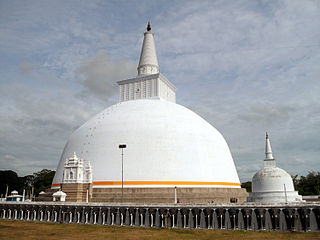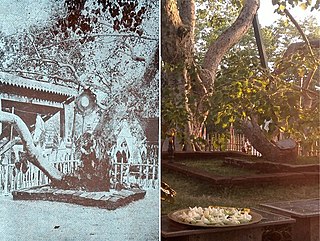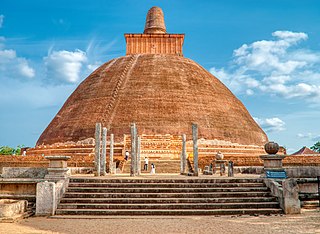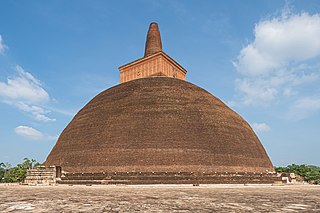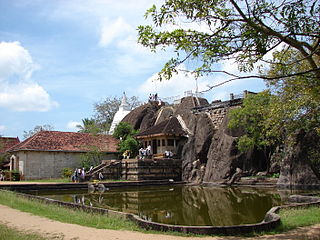5 Sights in Anuradhapura, Sri Lanka (with Map and Images)
Legend
Premium Sights
Book tickets, guided tours and activities in Anuradhapura.
Guided Free Walking Tours
Book free guided walking tours in Anuradhapura.
Welcome to your journey through the most beautiful sights in Anuradhapura, Sri Lanka! Whether you want to discover the city's historical treasures or experience its modern highlights, you'll find everything your heart desires here. Be inspired by our selection and plan your unforgettable adventure in Anuradhapura. Dive into the diversity of this fascinating city and discover everything it has to offer.
Activities in Anuradhapura1. Ruwanwelisaya Dagoba
The Ruwanweli Maha Seya, also known as the Maha Thupa, is a stupa in Anuradhapura, Sri Lanka. Two quarts or one Dona of the Buddha's relics are enshrined in the stupa, making it the largest collection of his relics anywhere. It was built by Sinhalese King Dutugemunu in c. 140 B.C., who became king of Sri Lanka after a war in which the Chola King Elāra (Ellalan) was defeated. It is also known as Swarnamali Seya, Svaṇṇamāli Mahaceti and Rathnamali Seya.
2. Jaya Sri Maha Bodhi
Jaya Sri Maha Bodhi Tree is a historical sacred bo tree in the Mahamewuna Garden in historical city of Anuradhapura, Sri Lanka. This is believed to be a tree grown from a cutting of the southern branch from the historical sacred bo tree, Sri Maha Bodhi, which was destroyed during the time of Emperor Ashoka the Great, at Buddha Gaya in India, under which Siddhartha Gautama (Buddha) attained Enlightenment. In 236 BC, the Buddhist nun Sangamitta Maha Theri, a daughter of Indian Emperor Ashoka, brought the tree cutting to Sri Lanka during the reign of Sinhalese King Devanampiya Tissa.[1] At more than 2,300 years old, it is the oldest living human-planted tree in the world with a known planting date. The Mahavamsa, or the great chronicle of the Sinhalese, provides an elaborate account of the establishment of the Jaya Sri Maha Bodhi on the Island and the subsequent development of the site as a major Buddhist pilgrimage site.
3. Jethavana Dagoba
The Jetavanarama stupa or Jetavanaramaya is a stupa, or Buddhist reliquary monument, located in the ruins of Jetavana monastery in the UNESCO world heritage city of Anuradhapura, Sri Lanka. At 122 metres (400 ft), it was the world's tallest stupa, and the third tallest structure in the world when it was built by King Mahasena of Anuradhapura (273–301). He initiated the construction of the stupa following the destruction of the Mahaviharaya of Anuradhapura. His son Kithsirimevan completed the construction of the stupa, and it was renovated by Parakramabahu I of Polonnaruwa. A part of a belt tied by the Buddha is believed to be the relic that is enshrined here.
4. Abhayagiriya Dagoba
Abhayagiri Vihāra was a major monastery site of Theravada, Mahayana and Vajrayana Buddhism that was situated in Anuradhapura, Sri Lanka. It is one of the most extensive ruins in the world and one of the most sacred Buddhist pilgrimage cities in the nation. Historically it was a great monastic center as well as a royal capital, with magnificent monasteries rising to many stories, roofed with gilt bronze or tiles of burnt clay glazed in brilliant colours. To the north of the city, encircled by great walls and containing elaborate bathing ponds, carved balustrades and moonstones, stood "Abhayagiri", one of seventeen such religious units in Anuradhapura and the largest of its five major viharas. One of the focal points of the complex is an ancient stupa, the Abhayagiri Dagaba. Surrounding the humped dagaba, Abhayagiri Vihara was a seat of the Northern Monastery, or Uttara Vihara and the original custodian of the Tooth relic in the island.
5. Isurumuni Viharaya
Isurumuniya is a Buddhist temple situated near to the Tissa Wewa in Anuradhapura, Sri Lanka. There are four carvings of special interest in this Vihara. They are the Isurumuniya Lovers, Elephant Pond and The Royal Family.
Share
How likely are you to recommend us?
Disclaimer Please be aware of your surroundings and do not enter private property. We are not liable for any damages that occur during the tours.
